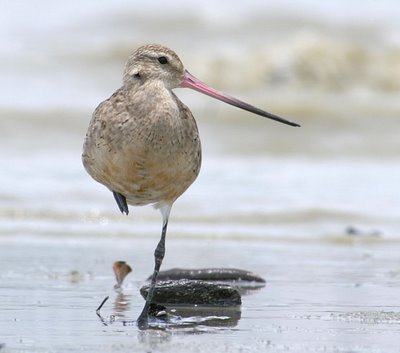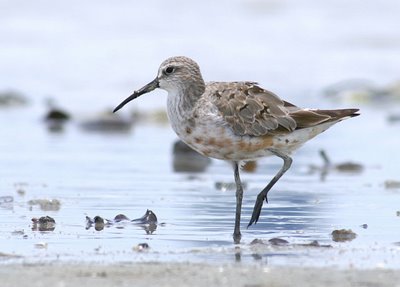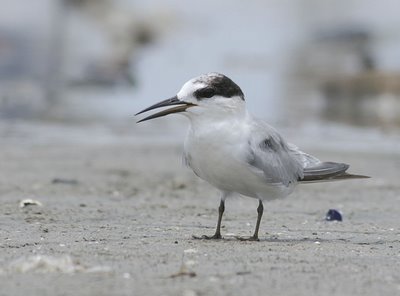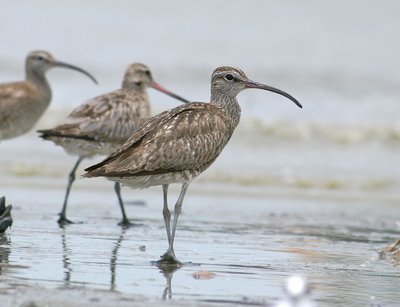Bar-tailed Godwit 10
Whimbrel 100
Greenshank 5
Common Redshank 20
Terek Sandpiper 8
Curlew Sandpiper 25
Common Sandpiper 3
Pacific Golden Plover 45
Greater Sand Plover 5
Lesser Sand Plover 150
Little Ringed Plover 2
Red-necked Stint 40
Great Knot 55
Red Knot 2
Ruddy Turnstone 11 (my record count)
Little Tern 60
This was after spending 3 or so hours in my makeshift 'hide'. I modified the design of Thursday's effort by adding a wooden box I found on the tideline, punching out a couple of slats and making it into a kind of miniature blind just big enough for me to stick my head and camera in. This gave me more freedom to move my head and hands without the movement being detected by the birds. I found that I frequently need to wipe the sweat from my face, and move my arms to stop pins and needles from getting too painful. I stuck a plastic crate in the box, into which I put my camera bag, which acted as a platform to rest the camera on.

My hide, Mark II
It's an amazing feeling, being on the same plane as the birds, and in some cases actually looking up to meet their eye level. I realize that for most of the world, the act of lying motionless on the mud in the midday tropical sun is a good definition of insanity, but all I can say is, for me it's an awesome privilege!
I took a load of pictures today. I caught the tide just right, and it came to within a few feet of me at its highest, which meant at one point I had Red-necked Stints so close I could almost hear them breathing!

Here's an adult Bar-tailed Godwit, still with traces of the chestnut breeding plumage on the belly. The bill seems really long, so this may be a female.

To be honest, I didn't spot the Red Knot in this picture (just right of centre)till I looked at the picture on the computer. Red Knots migrate through my native UK in the thousands, while Great Knot is an extreme rarity. Here though, it's the Red Knot that is more unusual, though not stunningly rare. The other birds in this picture are: Bar-tailed Godwit (a couple extreme right), Curlew Sandpiper (the out of focus bird in the foreground)and Great Knots. The three birds with black breastbands are still in breeding plumage, the others are also adults but have moulted into non-breeding dress.

This is an adult Greater Sand Plover. I've become quite fascinated by the subtle differences that separate this species from the sometimes very similar Lesser. For me one of the key differences is the bill shape - rather sharp-tipped, with a bulbous distal half. The legs are longer and generally yellower, but there is some variation. For example, this bird has rather grey legs (like most Lesser) and some Lesser have olive-green legs (like most Greater!). Overall though, Greater looks rather an ungainly beast, with a big head, while Lesser seems better proportioned.

By contrast, here's a really long-billed Lesser Sand Plover (probably a female, still in breeding dress). However, the bill is blunt-tipped, is bulbous only for the distal third, and is much slimmer, especially at the base, than Greater. The legs are shorter than Greater, and are grey, typically for a Lesser.

From plovers to sandpipers. Plovers tend to feed by sight and pick prey from the surface of the mud, while sandpipers locate prey using the soft, sensitive tip of the bill when probing in the mud. Plovers tend to have big eyes and short thick bills. They feed using a stop-start action; stopping to look and listen, then walking or running forward to catch prey. Sandpipers, on the other hand, have relatively smaller eyes and longer, thinner bills. They generally feed by probing more or less constantly into the mud. This is an adult Curlew Sandpiper, with a few chestnut belly and checkered upperpart breeding feathers. The rest of the pluamge consists of fresh much drabber coloured non-breeding feathers.

This photo is uncropped, taken using a 400mm lens, so it gives an idea of how close this tiny bird was. It's a Red-necked Stint - another member of the sandpiper family, and an adult. The dark-centred feathers on the 'back' and crown are old breeding feathers. So are the very abraded tertials (the long pointy dark brown feathers that cover the wingtips). Feather edges wear away with age, especially paler areas which lack pigmentation. The more uniform grey feathers are fresh non-breeding feathers. Some have a thin fringe of white at the tips, which will quickly wear away.

Here's the same species, but looking very different in complete non-breeding plumage from the previous individual. Maybe this is one reason why some people find waders difficult and confusing. Learning about the moult cycle and using good quality field guides that show different plumages accurately is a great help. So are good quality optics, taking notes and having loads of patience!

A Little Tern, looking very different from breeding birds that have bright yellow, black-tipped bills.

A Whimbrel, with a Bar-tailed Godwit in the background. The wing coverts and tertials of this birds are extremely worn - right down to the quill in some cases. All the white parts of the feathers have worn away completely, leaving the bird looking a dull brown overall.
No comments:
Post a Comment